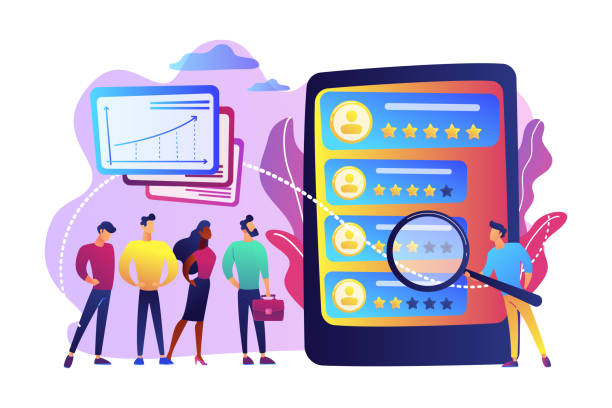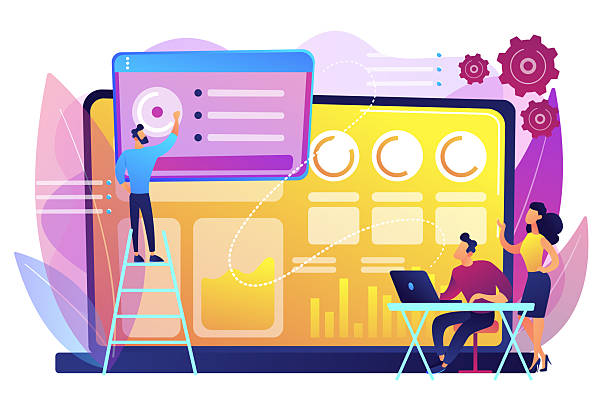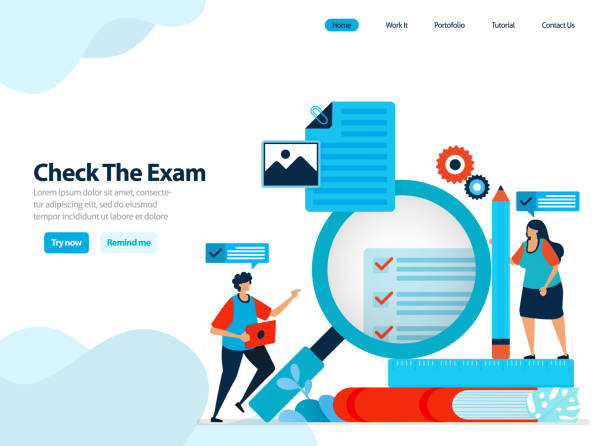Introduction to the Importance of Fast Website Design

In today’s fast-paced world, #website_speed is no longer a competitive advantage, but an absolute necessity.
User experience increasingly relies on page loading speed, and every second of delay can mean losing potential visitors and customers.
The importance of fast website design lies in its ability to retain user attention and reduce bounce rates.
A slow website not only frustrates users but can also severely damage your ranking in Google search results.
Today, search engines increasingly view page loading speed as a critical ranking factor.
Therefore, if you are looking for a successful online presence, investing in fast website design and optimizing its performance is a vital step.
Furthermore, in an era where internet access through mobile devices has become widespread, optimizing speed for mobile is of particular importance.
Mobile users often use the internet at varying speeds, and a slow site can quickly discourage them from continuing to browse.
This issue not only affects user experience but also directly impacts your inbound traffic and business potential.
Understanding these explanatory principles and applying them in the process of website design and development will guarantee your long-term success.
In this article, we will delve deeper into the factors affecting speed and practical solutions for achieving an incredibly fast website.
Speed is the key to retaining users and enhancing their experience.
Does your current corporate website present a worthy image of your brand and attract new customers?
If not, transform this challenge into an opportunity with Rasaweb’s professional corporate website design services.
✅ Significantly improves your brand credibility and image.
✅ Paves the way for attracting new leads and customers.
⚡ For free and expert consultation, contact Rasaweb now!
Key Factors in Website Speed

To achieve #fast_website_design, a precise understanding of the factors influencing it is crucial.
These factors range from #hosting_infrastructure to #coding and site content.
One of the most important is web hosting quality.
Slow servers or improper configurations can bring even the fastest code to its knees.
Choosing a reputable hosting provider that matches your site’s traffic needs is the cornerstone of a fast website.
Another important factor is the size and optimization of visual content such as images and videos.
Large, uncompressed images can significantly increase page load times.
Using modern image formats and proper compression is an important specialized step in this regard.
Furthermore, site coding plays a pivotal role.
Unclean, redundant, or heavy #HTML, #CSS, and #JavaScript codes can reduce page rendering speed.
Optimizing codes, removing unnecessary code, and using asynchronous loading methods for scripts help accelerate loading.
Also, excessive use of plugins and external scripts, without thoroughly examining their impact on performance, can lead to significant slowdowns.
An analytical understanding of these factors and addressing each with a specialized approach allows you to have a fast and efficient website design.
Every component of the website, from the smallest code to the largest image, affects its final speed, requiring a comprehensive approach to optimization.
Optimizing Images and Media: A Guide for Fast Website Design

#Images and #media are often the biggest reason for slow website loading.
To achieve fast website design, optimizing them is a crucial guiding step.
The first step is #image_compression without noticeable quality loss.
Many online tools and WordPress plugins are available for this, helping you significantly reduce file sizes.
Using appropriate image formats is also important.
For photos, JPEG, and for images with transparency, PNG are good options.
However, modern formats like WebP, introduced by Google, can offer better compression while maintaining quality.
The next step is using the Lazy Loading feature.
This feature ensures that images and videos are only loaded when the user scrolls to their respective section on the page, not at the initial page load.
This technique significantly reduces initial page load time and provides a better user experience.
Also, setting the correct dimensions for images in HTML or CSS code prevents browser stretching and shrinking of images, which itself increases rendering speed.
These guiding recommendations are an integral part of a comprehensive strategy for fast website design.
In the following, a guide table for image formats and their uses is provided:
| Format | Primary Use | Advantages | Disadvantages |
|---|---|---|---|
| JPEG | Real photos, detailed images | Excellent compression with relative quality preservation, wide support | No transparency support, quality degradation with high compression |
| PNG | Logos, icons, images with transparency or text | Transparency support, high quality preservation | Higher file size than JPEG for photos |
| WebP | Modern alternative for JPEG and PNG | Excellent compression (30% less than JPEG/PNG), transparency support | Browser support not yet complete (but increasing) |
| SVG | Vector graphics, logos, icons, charts | Very small file size, infinite quality at any scale, editable with CSS/JS | Not suitable for real photos |
Choosing Suitable Hosting and CDN for Fast Website Design

Choosing suitable #hosting is one of the specialized and vital decisions to ensure fast website design.
Server quality, its location, and allocated resources all impact your website’s loading speed.
Shared hostings are cheaper, but their resources are divided among several websites, which can lead to slowdowns during peak traffic.
For websites with higher traffic, options such as VPS (Virtual Private Server), Dedicated Server, or Managed WordPress Hosting can offer better performance.
The geographical location of the server is also important; choosing a server close to your target audience reduces latency.
In addition to hosting, using a CDN (Content Delivery Network) is an advanced analytical step to further accelerate your website.
A CDN stores your website’s static content (such as images, CSS, JavaScript) on multiple servers worldwide.
When a user accesses your website, content is delivered from the closest CDN server to them, which significantly reduces loading time, especially for users in distant geographical locations.
A CDN not only contributes to fast website design but also improves website stability and security by distributing the load.
Choosing the right CDN and configuring it correctly requires specialized knowledge, but its results in performance improvement are unparalleled.
Tired of losing customers due to poor e-commerce website design? With Rasaweb, solve this problem forever!
✅ Increase sales and visitor-to-customer conversion rates
✅ Smooth and engaging user experience for your customers⚡ Get free consultation
Clean Coding and Database Optimization: A Training Guide for Speed

#Clean_coding and #database_optimization are two pillars of #fast_website_design.
Optimized and efficient HTML, CSS, and JavaScript codes play a vital role in page rendering speed.
One important educational principle in this regard is Minification (removing white spaces, comments, and unnecessary characters) of CSS and JS files, which reduces their size.
Also, Combining (merging) several small CSS or JS files into a larger one reduces the number of HTTP requests to the server and increases loading speed.
Using asynchronous loading techniques for scripts also prevents page rendering from being blocked and allows for faster content display.
In the database section, its optimization is a specialized and very important matter.
Over time, website databases can become filled with unnecessary information, empty, or unoptimized tables.
#Database_cleanup of redundant data such as old post revisions, spam comments, and trash items can reduce its size and improve query speed.
Optimizing database tables and correctly using indexes for frequently used fields can also significantly reduce database response time.
These actions not only contribute to fast website design but also increase the overall stability and performance of the site.
Learning and applying these educational techniques are essential for any developer looking to build high-performance websites.
The Role of Plugins and Scripts in Technical Speed Analysis

#Plugins and #external_scripts, although adding many features and functionalities to websites, can be one of the primary causes of slowdowns in #fast_website_design.
Every plugin or script, whether for traffic analysis (like Google Analytics), advertising, or adding specific features, requires loading CSS and JavaScript files and sometimes making HTTP requests to external servers.
A precise analysis of each plugin’s impact on website speed is essential.
An unoptimized plugin can add hundreds of kilobytes of code and several server requests, which collectively significantly increases loading time.
To counteract this problem, the following analytical approach is suggested: First, only use plugins and scripts that are absolutely essential.
Before installing any new plugin, research and read user reviews regarding its performance and impact on speed.
Secondly, regularly review existing plugins and scripts and remove those you do not use.
Thirdly, use Performance Plugins that provide functionalities such as Caching, Minification, and Lazy Loading for other plugins and scripts.
These tools can help you control the loading of scripts and optimize them, effectively assisting in fast website design.
This precise analysis and intelligent management of plugins are important steps in maintaining and improving website speed.
Speed Testing and Performance Analysis Tools: An Educational Guide

To ensure #fast_website_design and continuous monitoring of its performance, using #speed_testing_tools is essential.
These tools, by providing comprehensive and specialized reports, reveal your website’s strengths and weaknesses in terms of speed.
One of the most well-known and widely used of these tools is Google PageSpeed Insights, provided by Google itself, which examines various metrics including First Contentful Paint, Largest Contentful Paint, and Cumulative Layout Shift.
This tool offers specific suggestions for improving speed on desktop and mobile versions.
Another powerful tool is GTmetrix, which, with deeper analysis, displays waterfall charts of requests, allowing you to precisely understand which elements on your site take a long time to load.
WebPagetest is also a more advanced tool that enables testing from various geographical locations and with different connection speeds, providing very precise analytical insights.
These tools are not only helpful for identifying issues but also serve as an educational resource, teaching you how to diagnose and resolve performance problems.
Regularly using these tools and implementing their suggestions is a fundamental step in maintaining and continuously improving fast website design.
In the following, a comparative table of popular speed testing tools is presented:
| Tool Name | Advantages | Disadvantages | Main Focus |
|---|---|---|---|
| Google PageSpeed Insights | Free, precise Google suggestions, Core Web Vitals scoring | Sometimes complex technical explanations, may not have enough details for developers | Scoring and general suggestions for SEO and user experience |
| GTmetrix | Comprehensive Waterfall reports, displays loading time of each element, examines key performance factors | Sometimes requires registration for some features, may be a bit complex for beginners | Deep technical analysis and identification of bottlenecks |
| WebPagetest | Advanced settings (location, connection speed, browser), video recording of page loading | High complexity for ordinary users, older user interface | Custom and advanced tests for specialists |
| Pingdom Tools | Simple and user-friendly, displays waterfall chart, tracks performance history | Suggestions sometimes more general than other tools, limitations in free testing | Overall speed testing and identification of slow files |
Fast UX and Increased Conversion Rates: Questionable Content

Did you know that #website_speed directly impacts #user_experience (UX) and consequently your #conversion_rate? This is a debatable point that business owners often underestimate.
A fast website design means that users can quickly access the information they need, without encountering delays and long loading times.
This not only leads to user satisfaction but also significantly increases the likelihood of them staying on the site, visiting more pages, and eventually converting into customers.
Conversely, even a few seconds of loading delay can lead to an increased Bounce Rate and reduced user engagement.
When a website is fast, users feel more efficient and in control.
This creates a positive experience that stays in their minds.
This fast website design not only positively impacts SEO but is also directly linked to your business goals.
For an e-commerce site, faster product page loading can directly lead to increased sales.
For a blog, high speed encourages more readers to read and share your articles.
So, the question is: Is your business ready to lose potential customers because of a few seconds of delay? Improving speed is not just a technical action but a strategic investment for your business growth, emphasizing the analytical importance of speed in the competitive online space.
Did you know a weak corporate site costs you many opportunities daily? Solve this problem forever with professional corporate website design by Rasaweb!
✅ Create a powerful and reliable image for your brand
✅ Targeted attraction of new customers and increased sales
⚡ [Get Free Website Design Consultation]
Success Stories in Fast Website Design: News and Entertainment

In the #web world, there are many success stories in the field of #fast_website_design that demonstrate how speed optimization can have a #significant_impact on businesses.
This section focuses on the news and entertainment aspect of the topic.
For example, one of the most famous stories relates to the Amazon website, which reported that every 100 milliseconds improvement in page load speed resulted in a 1% increase in sales.
This statistic shows that even the smallest optimizations can lead to significant financial results.
Another website that is a prime example of the importance of fast website design is Walmart.
After optimizing their website speed, they saw an increase in conversion rates and a decrease in bounce rates.
These examples are not only inspiring but also a warning: if e-commerce giants with billions in revenue are still looking for millisecond improvements in speed, then what about your website? There are also other stories about blogs and news websites whose traffic and user engagement significantly increased after focusing on speed.
These news and entertaining examples demonstrate that fast website design is not just a technical advantage, but a business strategy that can change your online destiny.
These phenomena attest to the claim that speed is a key factor in user experience and ultimately business success.
The Future of Fast Website Design and New Explanatory Trends

The future of #fast_website_design is intertwined with #emerging_technologies and new trends aimed at providing users with an ever-faster and smoother experience.
One of the most important of these trends is the development and expansion of Progressive Web Apps (PWA).
PWAs offer a combination of the best features of websites and mobile applications; they are fast, reliable, and installable on the phone’s home screen, and can even work offline.
These features significantly improve user experience and minimize initial loading speed.
Another trend is the use of AMP (Accelerated Mobile Pages), a Google project aimed at creating web pages with near-instant loading on mobile devices.
AMP, by using restricted HTML and CSS and specific optimizations, allows pages to load in less than a second, which is very useful for news content and blogs.
Furthermore, the use of HTTP/3 and QUIC as new communication protocols promises faster and more secure communications between browsers and servers.
These technical explanations show that focusing on fast website design is not just a current trend, but a fundamental basis for the future of the web.
Developers and website owners should be aware of these new technologies and incorporate them into their strategies to maintain competitiveness in the online space.
These news trends shape the future of the web.
Frequently Asked Questions
| Question | Answer |
|---|---|
| What is fast website design? | The process of building websites that load at high speed. |
| Why is website speed important? | It improves user experience, positively impacts SEO, and increases conversion rates. |
| What factors affect website loading speed? | Server speed, image size, code optimization, use of browser cache. |
| How can website speed be increased? | Optimizing images, compressing CSS and JavaScript files, using a CDN, and choosing suitable hosting. |
| What are common tools for testing website speed? | Google PageSpeed Insights, GTmetrix, Pingdom Tools. |
| Does server geographical location affect speed? | Yes, less distance between the user and the server leads to less latency and higher speed. |
| What does image optimization mean? | Reducing the file size of images without significantly compromising their quality. |
| What is browser cache and how does it help speed? | Temporary storage of website resources (like images, CSS, and JS files) in the user’s browser for faster loading on subsequent visits. |
| What is the impact of site speed on SEO? | Google considers site speed as a ranking factor; faster sites generally achieve better rankings. |
| How can CSS and JavaScript files be optimized? | By minifying and concatenating files to reduce size and the number of requests. |
And other services of Rasaweb Advertising Agency in the field of advertising
Smart Custom Software: Designed for businesses seeking to increase sales through marketing automation.
Smart Social Media: A professional solution for increasing click-through rates with a focus on custom programming.
Smart Link Building: An innovative platform to improve customer behavior analysis using real data.
Smart Advertorials: A combination of creativity and technology for online growth through custom programming.
Smart Sales Automation: A new service for increasing click-through rates through marketing automation.
And over hundreds of other services in the field of online advertising, advertising consulting, and organizational solutions
Online Advertising | Advertising Strategy | Advertorials
Resources
Why is Website Speed Crucial for Online Success?
The Amazing Impact of Website Speed on SEO Ranking
Comprehensive Guide to Website Speed Optimization
Web Speed and Its Role in E-commerce Success
? To elevate your business in the digital world, Rasaweb Digital Marketing Agency is your smart companion. With us, you will have a complete experience of professional services, from website design with a modern user interface to comprehensive SEO and content marketing strategies.
📍 Tehran, Mirdamad Street, Next to Central Bank, Southern Kazeroun Alley, Ramin Alley, No. 6




